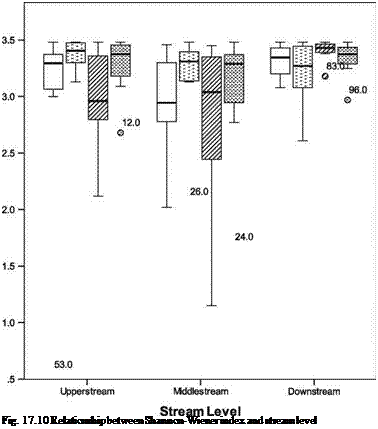17.4.3.1 Plants and Animals for Family Health
The production of plants and animals in pekarangan gave much nutrition that significantly influenced the family’s health. Four nutrition types were elaborated to determine the contribution of pekarangan production to a family’s diet: calories, protein, vitamin A, and vitamin C. There were no statistically significant differences for those nutritional values between G1, G2, G3, and G4 in family
Group

![]() Leel
Leel
□ Group 1 E3 Group 2 0 Group 3 ЁЭ Group 4
|
Upperstream |
Middlestream |
Downstream |
||
|
Upperstream |
X |
0.52 |
0.67 |
|
|
Middlestream |
X |
X |
0.63 |
|
|
Downstream |
X |
X |
X |
|
|
G1 |
G2 |
G3 |
G4 |
|
|
G1 |
X |
0.44 |
0.48 |
0.42 |
|
G2 |
X |
X |
0.69 |
0.58 |
|
G3 |
X |
X |
X |
0.62 |
|
G4 |
X |
X |
X |
X |
|
Fig. 17.11 Similarity index among stream levels and among groups |
|
Calorie Protein Vitamin A Vitamin C |
|
Group |
kcal |
To Total (%) |
To RDA (%) |
gram |
To Total (%) |
To RDA (%) |
IU |
To Total (%) |
To RDA (%) |
mg |
To Total (%) |
To RDA (%) |
|
G1 |
52.9 |
0.82 |
0.92 |
1.8 |
0.97 |
1.09 |
78.7 |
10.09 |
11.35 |
18.7 |
15.61 |
17.56 |
|
G2 |
107.9 |
1.40 |
1.64 |
2.5 |
1.20 |
1.41 |
104.4 |
11.59 |
13.60 |
52.6 |
23.48 |
27.57 |
|
G3 |
181.9 |
2.59 |
2.09 |
4.6 |
2.57 |
2.07 |
98.8 |
15.99 |
12.87 |
45.8 |
25.23 |
20.31 |
|
G4 |
208.6 |
3.05 |
2.90 |
7.1 |
3.25 |
3.10 |
87.2 |
12.31 |
11.73 |
43.7 |
30.49 |
29.06 |
|
Average |
137.8 |
1.97 |
1.89 |
4.0 |
2.00 |
1.92 |
92.3 |
12.50 |
12.39 |
40.2 |
23.70 |
23.63 |
|
RDA = recommended dietary allowance; To Total = to total consumption Fig. 17.12 Value of family consumption derived from pekarangan per day. Nutrition contribution from pekarangan to total consumption (%) and to recommended dietary allowance (RDA) (%). There were no significant differences between G1, G2, G3, and G4 on family consumption from pekarangan for all kinds of nutrition |
consumption from pekarangan. It can be concluded that the contribution of pekarangan is important for all groups without exception (Fig. 17.12).
Therefore, pekarangan is one recommended strategy for addressing malnutrition and micronutrient deficiencies, particularly for marginal people in a forest margin area or at the buffer zone of a protected area. A number of studies have found that pekarangan produce a significant percentage of plants such as fruits and vegetables for household consumption. In addition, a number of studies have concluded that pekarangan are associated with better household nutrition (Mitchell and Hanstad 2004).




